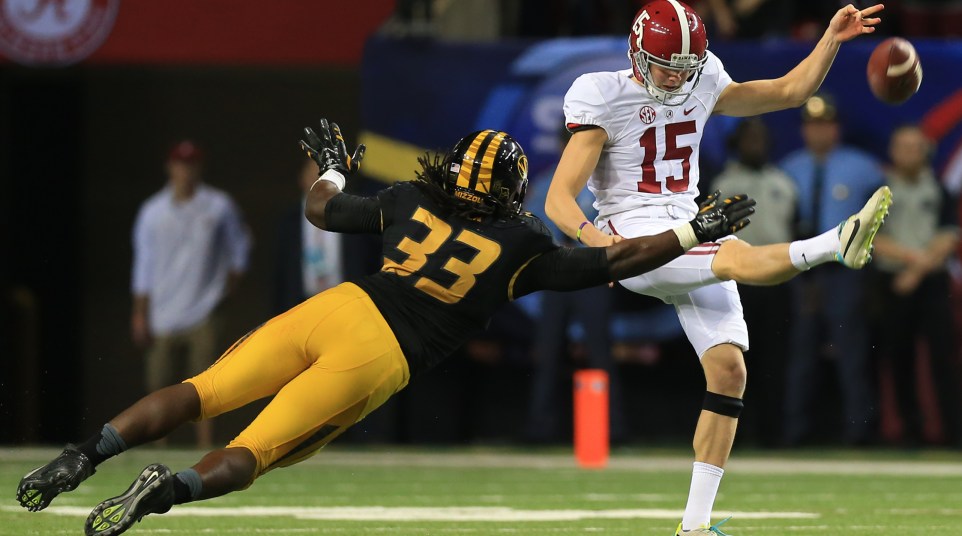How are specialists recruited to the SEC?
Have you ever wondered how specialists like place kickers, punters and long snappers are recruited? Every team has them, and yet because those positions are so unique in comparison to the other positions on the field we regard kickers and punters in a completely different manner than other football players.
But at the end of the day, kickers and punters are football players, too. They’re recruited to fill a role on the team, and are judged by coaches and fans based on how they perform at their position. No, they’re not 260-pound freight trains or gazelles with blazing speed in the open field. Without a ball at their foot, most won’t impress you physically as much as an SEC linebacker or tailback.
Still, college football’s specialists all come from somewhere, and their particular sets of skills are vital to a program’s success. Remember last year’s Sugar Bowl? Alabama freshman punter JK Scott was one of the best players on the field that day.
Which brings us back to the question that began this article: How are specialists like Scott recruited? The process is just as unorthodox as you’d expect.
The recruitment of kickers, punters and long snappers varies based on a number of factors. Some specialists are recruited in a more traditional way: They send in highlight reels and workout tapes to coaches, attend regional or national camps to be scouted, and are assigned a star rating by 247Sports, Scout and the other major recruiting services. There are even kickers and punters invited to the Under Armour and U.S. Army All-America games each year.
These specialists are often the elite talents at the high school level, although even the best of the best are often rated as three-star recruits. In fact, there hasn’t been a single placekicker in the last five years to receive a rating better than three stars. Needless to say, it’s an extremely rare occurrence.
And these elite talents are often recruited like the elite talents at the other positions in that ability and upside are weighed more heavily than on-field results at the high school level. College coaches will nab premier athletes and move them to a new position at the college level based solely on athletic prowess. Top-tier specialists are no different; Scott, for example, was rated as a three-star placekicker (No. 1 in the class of 2014) but was moved to punter upon arriving in Tuscaloosa. Alabama had a kicker in place, but Nick Saban and his staff found a big leg and put it to good use right away.
But, like at the other positions, not everyone can be an elite talent. However, while at other positions the kids on the lower tiers of the recruiting rankings are still pursued in a similar manner as the top tier (sending in tapes, attending camps, weighing offers, etc.) the same cannot be said for specialists.
A number of programs rely on walk-ons to compete for specialist roles on the team. Many of these walk-ons played their position in high school, but perhaps not at an elite level, or perhaps they began playing football too late in the process to be properly recruited.
Many high schools find a big leg from the school’s soccer team to borrow as a kicker or punter, and even if that player turns out to make 50-yard field goals with ease, if he didn’t pick up the sport until his junior or senior year it’s tough for him to work his way onto the Division I radar.
Sometimes these kinds of specialists are brought in as preferred walk-ons, while other times they’re merely invited to attend the school and try out at the open walk-on tryouts that most schools hold each fall. Eventually they make their way onto the team thanks to their talent, but in a much more roundabout manner.
It’s worth noting that because you rarely need depth behind your primary kicker, punter and snapper, there are fewer prospects at each position than the others on the recruiting trail. Rarely do even as many as 100 specialists among the three positions earn a rating of any kind in the same year, which is due to a lesser annual turnover at the position from year to year compared to a position like cornerback or wide receiver. Thus, there is normally not as much of a need for specialists each year, and thus there are fewer prospects on the radar of most major college coaches.
Sometimes specialists are treated just like everyone else on the recruiting trail, while others are handled in a more unique manner. Some of the top specialists are easy to find, like the top players at any other position. Others are hidden in the rough where only a few dedicated coaches may uncover them.
But when a team is trailing by 2 points with 10 seconds left, there’s no one on the team more important than the snapper and kicker. And that’s why recruiting at those positions still matters, even if it’s handled in a strange way.

